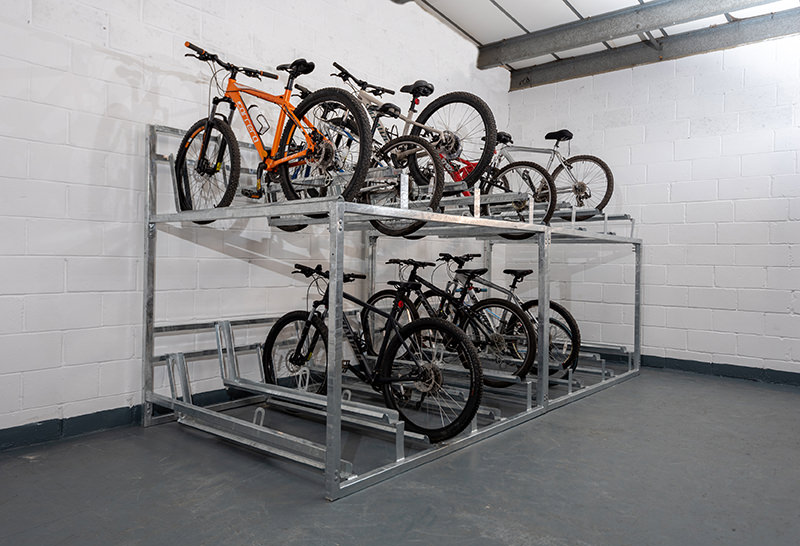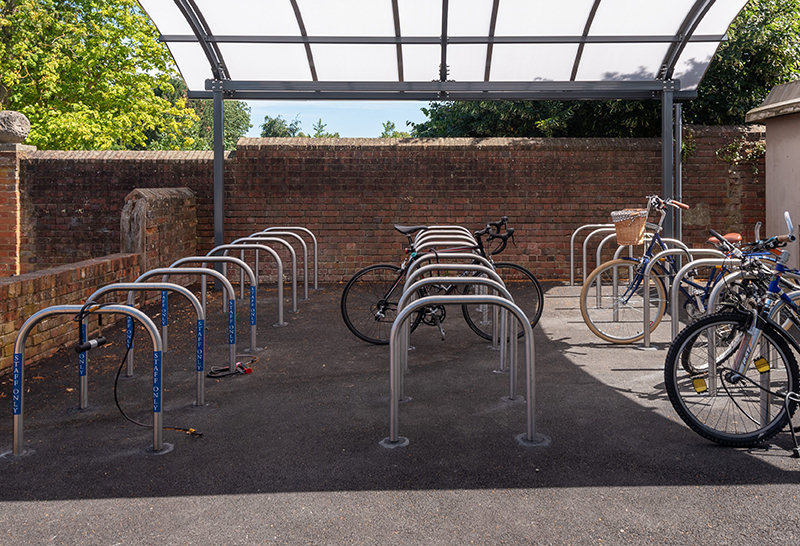Table of Contents:
77,148 bike thefts were reported to police across England and Wales across 2022/23. This equates to an incident every 7 minutes, while a recent survey found that 71% of bike theft victims didn’t bother to report it to police, meaning the overall figure is likely to be much higher. This data suggests the presence of secure, well-designed bike parking options can encourage more people to cycle, and, through appropriate designs and effective planning, combined with secure use by cyclists, reduce the likelihood of bike theft.
Providing cyclists with a designated parking area ensures that bikes are parked in an orderly and unobtrusive manner, playing a key role in improving cycling infrastructure as a whole, whether in public, commercial or residential settings. Bike parking is a valuable resource across a wide variety of sectors, and, as a commodity, its quality and appearance has progressed considerably over the years, in-line with the development of UK bike parking standards.
Bike Parking for Developments
While there is currently no fixed national policy for bike parking in the UK, most new-build developments will require provisions for bike parking. Planning decision notices will typically include conditions for both the type and capacity of bike parking spaces required, while local councils will often have their own specific guidelines and standards for residential bike parking facilities.
Bike parking for developments will typically be long-term, with appropriate cover a corresponding requirement. Aiming to provide a capacity of bike parking spaces that exceeds initial demand will help to accommodate future requirements and restrict potential shortcomings.
Limitations on the available footprint are often a challenge, so determining whether the secure bike storage facility will be an internal or external installation will be informative in terms of determining specific spatial requirements or potential restrictions on operational height. These aspects can be particularly challenging in high-density developments, and while there is bike parking designed specifically to maximise space in these environments, such as semi-vertical or two-tier racking systems, prioritising aspects such as location and layout will help to maximise accessibility and ensure standards are met.
Standards for Public Bike Parking
The Bicycle Association’s ‘Cycle Parking & Security Standards’ provides guidance intended to enable those installing and managing bike parking to identify installations which are:
- Easy for users to access, with considerations made towards those with mobility restrictions
- Of a durable build and resistant to corrosion
- Safe to use, for both the user and their bike
- Offers secure use and provides opportunities for effective locking systems
The standard is intended to be applicable for public bike parking procurement within the UK, referring to bike parking used by the general public in any building or environment that encompasses high-traffic and interchange, operated by either the private or public sector. The minimum requirements for public bike parking in the UK fall under ‘Guidance’, ‘Absolute Requirements’, and ‘Context Specific Requirements.’
Guidance
Bike parking should focus primarily on accessibility and security. The well-utilised sheffield stands and two-tier racking are suggested as the most appropriate forms of as they are widely accessible and provide assisted lifting, if necessary. Providing information on locking systems is seen as advantageous.
Appropriate designs should accommodate effective manoeuvrability of varying standard and non-standard bike forms, with ceiling heights considered if installing two-tier racks. Facilities should convey clear information to assist with access, secure use, and to provide intent.
Key Absolute Requirements
Facilities must be positioned to offer passive oversight and unable to cause obstruction, as well as enabling step-free access. Designs should accommodate those with visual or mobility impairments, while considering alternatives to standard bikes, such as those with wide tyres, with two-tier racks incorporating gas-assisted lifting.
Minimum security requirements require separate locking of both the frame and wheels of the bike, and facilities must be capable of passing Secured by Design Level 2 testing, or Level 1 when located in a secured environment. Minimum requirements for spacing between individual Sheffield stands are 1000mm and 600mm to any walls or kerbs. Two rows of Sheffield stands should provide 2500mm of space between aisles. For two-tier racks, 2500mm of frontal space is required if the stands are installed at 90 degrees to the aisle, or 2000mm when installed at 45 degrees, alongside a minimum ceiling height of 2700mm for the upper tier.
Context Specific Requirements
Bike parking should be installed as close to the site’s main destination as possible; within 15 metres of a single destination for short-term bike parking and 25 metres if serving multiple destinations. Long-term bike parking facilities should be within 50 metres.
Appropriate lighting must be provided to assist with access and the prevention of theft, with clear signage to provide information and assistance for users. For facilities with two-way bike access, 3000mm width must be provided, with a minimum 2000mm aisle width for access on foot.
Available as individual installations or incorporated into bike storage facilities to maximise capacity and provide cover from inclement weather, bike stands, racks and shelters enable short lead times, capacity format variations, and cost-effective value. Consulting industry specialists will help to provide expertise and advice on the most appropriate type of bike parking to meet specific project requirements.
- Sheffield stands are the traditional bike stand, offering a classic, minimalist design that provides quick-access bike parking. A cost-effective solution for environments that require small to medium capacity storage, Sheffield stands enable separate locking of both the wheels and frame helps to keep the bike stabilised, while minimum spacing between individual stands and rows should be considered. The tubular metal form is anchored to the ground at two points in an inverted U-shape with radius corners, offering 3 distinct fixing formats; rail fixed that reduces the number of ground fixings required to restrict potential trip hazards; base plated that enable ground fixings, and root fixed that are are cast in below ground level and are often utilised where a clean surface finish is required.
- Semi-vertical racks comprise a trough-like design that supports both the front and rear wheels in use, and they are often installed to maximise available floor space, offering efficient footprint utilisation for both width and length. Semi-vertical racks require minimal storage depth, enabling bikes to be secured in close proximity to one another. Fixed capacity designs are available alongside bespoke designs in order to meet individual requirements, and accommodating the diverse variety of bike ranges on the modern market, semi-vertical racks enable varying wheelbase bikes to be secured, providing secure bike parking for larger bikes with wider tyres.
- Two-tier racks achieve the maximum quantity of bikes stored per square metre, and where the available footprint is restricted, offer close to double the capacity in the same space. An ideal solution for bike parking in high-density environments, two-tier racks will typically offer an integral gas-assisted lifting system as a standard specification for bikes stored on the upper tier tray, with integral locking frames enabling varying bike sizes to be stored securely.
- Bike shelters provide a covered bike parking facility and are often combined with stands or racks with a single or double row system. A semi-enclosed design can be supplemented with additional modules to form an enclosed bike shelter compound. However, limited options to enhance security means they are typically more appropriate for enclosed sites and short-term parking where quick access for multiple users is a requirement.
urbanspec Bike Parking
As sustainability strategies and urban planning develops, the requirement for innovative, high-quality bike parking products is increasing. urbanspec advanced manufacturing of high volume bike parking products enables short lead times and capacity format variations, with all types available from stock as standalone or pre-configured to maximise capacity when incorporated into bike stores and shelters. In addition to standard product configurations, urbanspec integrated design and engineering methodology make bespoke bike shelter builds possible within proven design formats.
A substantial resource and knowledge base enables urbanspec to simplify specifications, utilising CAD models, NBS specifications and datasheets available for download. Supporting CPD programmes provide clarity on the optimal approach to aspects such as security considerations and effective space planning.







